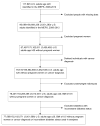The Burden of Obesity on Diabetes in the United States: Medical Expenditure Panel Survey, 2008 to 2012
- PMID: 28212973
- PMCID: PMC5319814
- DOI: 10.1016/j.jval.2016.08.735
The Burden of Obesity on Diabetes in the United States: Medical Expenditure Panel Survey, 2008 to 2012
Abstract
Background: Diabetes is one of the most prevalent and costly chronic diseases in the United States.
Objectives: To analyze the risk of developing diabetes and the annual cost of diabetes for a US general population.
Methods: Data from the Medical Expenditure Panel Survey, 2008 to 2012, were used to analyze 1) probabilities of developing diabetes and 2) annual total health care expenditures for diabetics. The age-, sex-, race-, and body mass index (BMI)-specific risks of developing diabetes were estimated by fitting an exponential survival function to age at first diabetes diagnosis. Annual health care expenditures were estimated using a generalized linear model with log-link and gamma variance function. Complex sampling designs in the Medical Expenditure Panel Survey were adjusted for. All dollar values are presented in 2012 US dollars.
Results: We observed a more than 6 times increase in diabetes risks for class III obese (BMI ≥ 40 kg/m2) individuals compared with normal-weight individuals. Using age 50 years as an example, we found a more than 3 times increase in annual health care expenditures for those with diabetes ($13,581) compared with those without diabetes ($3,954). Compared with normal-weight (18.5 ≤ BMI < 25 kg/m2) individuals, class II obese (35 ≤ BMI < 40 kg/m2) and class III obese (BMI ≥ 40 kg/m2) individuals incurred an annual marginal cost of $628 and $756, respectively. The annual health care expenditure differentials between those with and without diabetes of age 50 years were the highest for individuals with class II ($12,907) and class III ($9,703) obesity.
Conclusions: This article highlights the importance of obesity on diabetes burden. Our results suggested that obesity, in particular, class II and class III (i.e., BMI ≥ 35 kg/m2) obesity, is associated with a substantial increase in the risk of developing diabetes and imposes a large economic burden.
Keywords: diabetes; economic burden; health care expenditures; obesity.
Copyright © 2017 International Society for Pharmacoeconomics and Outcomes Research (ISPOR). Published by Elsevier Inc. All rights reserved.
Figures




References
-
- Martinez ME, Maltzman T, Marshall JR, Einspahr J, Reid ME, Sampliner R, et al. Risk factors for Ki-ras protooncogene mutation in sporadic colorectal adenomas. Cancer Res. 1999;59(20):5181–5. - PubMed
-
- Gil MJ, Manu MA, Arteaga C, Migliaccio M, Encio I, Gonzalez A, et al. Synthesis and cytotoxic activity of N-(2-pyridylsulfenyl)urea derivatives. A new class of potential antineoplastic agents. Bioorg Med Chem Lett. 1999;9(16):2321–4. - PubMed
Publication types
MeSH terms
Grants and funding
LinkOut - more resources
Full Text Sources
Other Literature Sources
Medical

